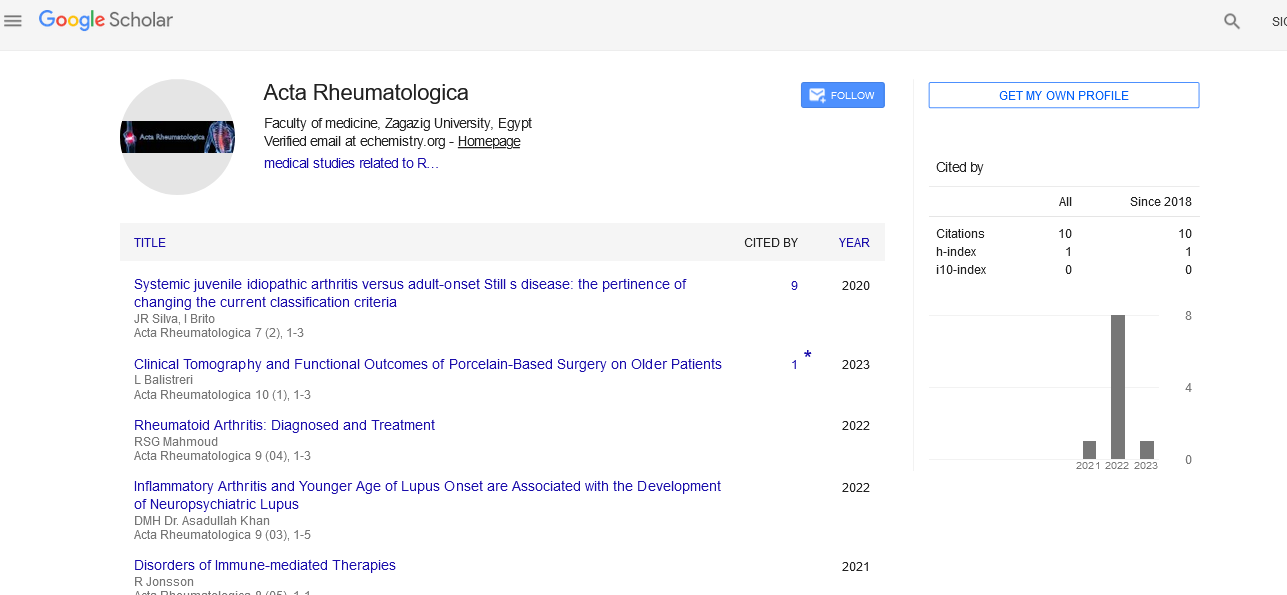Perspective - (2023) Volume 10, Issue 5
Rheumatoid Arthritis: Understanding, Managing, and Improving Quality of Life
Ping Seung Ong*
Department of Glucosamine and Rheumatologica, AIMST University, Malaysia
*Correspondence:
Ping Seung Ong, Department of Glucosamine and Rheumatologica, AIMST University,
Malaysia,
Email:
Received: 12-Sep-2023, Manuscript No. ipar-23-14257;
Editor assigned: 15-Sep-2023, Pre QC No. ipar-23-14257 (PQ);
Reviewed: 10-Feb-2023, QC No. ipar-23-14257;
Revised: 05-Oct-2023, Manuscript No. ipar-23-14257 (R);
Published:
13-Oct-2023
Introduction
Rheumatoid Arthritis (RA) is a chronic autoimmune
disorder characterized by inflammation, pain, and joint
damage. This condition affects approximately 1% of the
world's population and can lead to significant challenges
in daily life. This article aims to explore the complexities
of rheumatoid arthritis, encompassing its causes,
symptoms, treatments, and lifestyle strategies to improve
the quality of life for those affected.
Understanding rheumatoid arthritis
Rheumatoid arthritis is an autoimmune disorder where
the body's immune system mistakenly attacks the
synovium-the lining of the membranes that surround the
joints. This results in inflammation, causing pain,
swelling, and eventual damage to the cartilage and bone
within the joint.
Causes and risk factors
While the exact cause of rheumatoid arthritis remains
unknown, it is believed to be a combination of genetic,
environmental, and immune system factors. Some
potential risk factors include family history, genetic
predisposition, smoking, and certain infections that may
trigger the immune system response leading to RA.
Symptoms and effects
The hallmark symptoms of rheumatoid arthritis include:
• Joint pain, swelling, and stiffness, particularly in
smaller joints like fingers and toes
• Fatigue, fever, and general malaise
• Morning stiffness that lasts for more than an hour
• Symmetrical joint involvement (meaning both sides of
the body are usually affected)
• Over time, untreated RA can lead to joint damage,
deformities, and loss of function, impacting daily
activities and reducing the quality of life.
Diagnosing rheumatoid arthritis
Diagnosis typically involves a combination of physical
examinations, blood tests (such as checking for antibodies
like rheumatoid factor and anti-citrullinated protein
antibodies), imaging tests (X-rays, ultrasounds, or MRIs),
and consideration of symptoms and medical history.
Description
Treatments and management
Medications: Disease-Modifying Antirheumatic Drugs
(DMARDs) are the primary medications used to slow
down or stop the progression of RA. Corticosteroids and
Nonsteroidal Anti-Inflammatory Drugs (NSAIDs) are
often used for pain relief and reducing inflammation.
Biologic therapies: These newer medications target specific
parts of the immune system to reduce inflammation and
prevent joint damage.
Lifestyle changes: Regular exercise, including strength
training and low-impact activities, can improve joint
flexibility and reduce stiffness. A balanced diet and
maintaining a healthy weight also play a significant role in
managing RA symptoms.
Physical and occupational therapy: These therapies assist
in improving joint function, managing daily activities, and
preventing joint deformities.
Surgery: In severe cases where joint damage is extensive,
surgical interventions like joint replacement may be
necessary.
Lifestyle strategies to improve quality of
life
Pain management techniques: Heat and cold therapy,
massages, and relaxation techniques can assist in managing
pain and reducing joint stiffness.
Support networks and mental health: Engaging with
support groups, family, and friends helps in coping with the
emotional toll of living with a chronic condition. Seeking
counseling or therapy can also aid in managing the mental
health aspects of dealing with RA.
Adaptive tools and techniques: Using assistive devices,
ergonomic furniture, and learning adaptive techniques can
help reduce strain on the joints and improve functionality.
Stress management: Stress can exacerbate RA symptoms.
Techniques such as mindfulness, meditation, and relaxation
exercises can help in managing stress levels.
Regular check-ups and communication with healthcare
providers: Regular consultations with healthcare
professionals and open communication regarding
symptoms and concerns are crucial in managing RA
effectively.
Skin
The rheumatoid knob, which is in some cases in the skin,
is the most well-known non-joint component and
happens in 30% of individuals who have RA. It is a sort
of provocative response referred to pathologists as a
"necrotizing granuloma". The underlying pathologic cycle
in knob development is obscure however might be
basically equivalent to the synovitis, since comparative
primary elements happen in both. The knob has a focal
area of fibrinoid rot that might be fissured and which
relates to the fibrin-rich necrotic material tracked down in
and around an impacted synovial space. Encompassing
the rot is a layer of palisading macrophages and
fibroblasts, relating to the intimal layer in synovium and a
sleeve of connective tissue containing bunches of
lymphocytes and plasma cells, comparing to the
subintimal zone in synovitis. The common rheumatoid
knob might be a couple of millimeters to a couple of
centimeters in breadth and is typically tracked down over
hard prominences, like the elbow, the heel, the knuckles,
or different regions that support rehashed mechanical
pressure.
Knobs are related with a positive RF (rheumatoid
component) titer, ACPA, and extreme erosive joint pain.
Seldom, these can happen in inward organs or at different
locales on the body. A few types of vasculitis happen in RA,
yet are for the most part seen with well-established and
untreated illness. The most well-known show is because of
contribution of little and medium-sized vessels.
Rheumatoid vasculitis can hence ordinarily give skin
ulceration and vasculitic nerve localized necrosis known as
mononeuritis multiplex. Other, rather uncommon, skin
related side effects incorporate pyoderma gangrenosum,
Sweet's condition, drug responses, erythema nodosum,
curve panniculitis, decay of finger skin, palmar erythema,
and skin delicacy (frequently deteriorated by corticosteroid
use). Diffuse alopecia areata (Diffuse AA) happens all the
more ordinarily in individuals with rheumatoid arthritis.
RA is additionally seen all the more frequently in those
with family members who have AA.
Conclusion
Rheumatoid arthritis is a complex condition that requires
a multidisciplinary approach for effective management.
Understanding its causes, symptoms, and available
treatments is pivotal for those affected by RA. Embracing
lifestyle changes, seeking appropriate medical care, and
adopting strategies to manage symptoms and improve
overall well-being significantly impact the quality of life
for individuals living with rheumatoid arthritis. Ongoing
research and advancements in treatment options offer
hope for better outcomes and improved strategies for
coping with this chronic condition.





